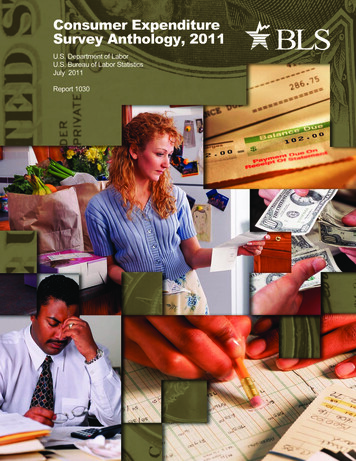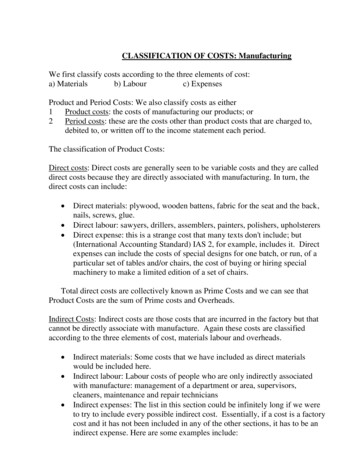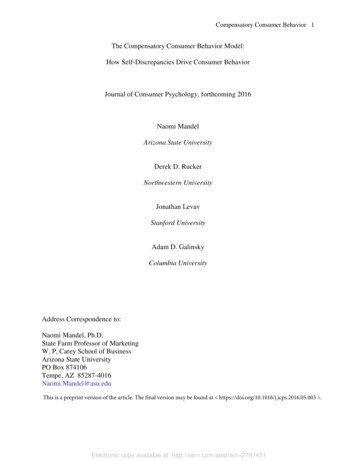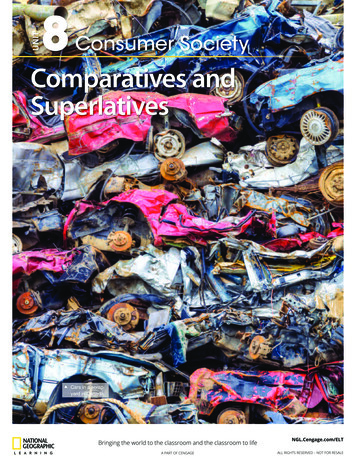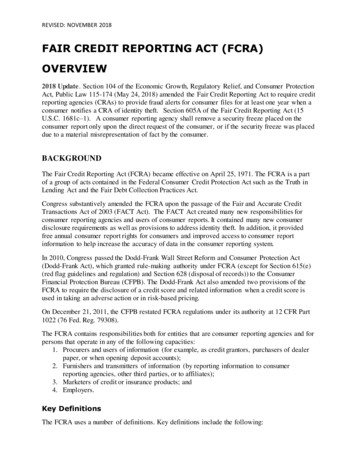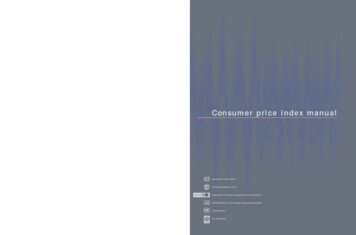
Transcription
the rate at which the prices of consumer goodsand services are changing over time.It is a key statistic for purposes of economicand social policy-making, especially monetarya n dp r a c t i c eThe consumer price index (CPI) measuresT h e o r yConsumer price index manual:T h e o r y a n d p r a c t i c eand wide-ranging implications for governments,businesses and workers, as well as households.This important and comprehensive manualprovides guidelines for statistical offices andother agencies responsible for constructingCPIs and explains in depth the methods thatare used to calculate a CPI. It also examines3165140 163361ISBN 92-2-113699-Xthe underlying economic and statisticalconcepts and principles needed for makingchoices in efficient and cost-effective waysand for appreciating the full implicationsof those choices.The following international organizations,concerned both with the measurement ofinflation and with policies designed to controlit, have collaborated on the preparationof this manual: the International LabourOffice; the International Monetary Fund; theOrganisation for Economic and Co-operationand Development; the Statistical Officeof the European Communities (Eurostat);the United Nations Economic Commissionfor Europe; and the World Bank.Consumer price index manual :policy and social policy, and has substantialConsumer price index manualTheoryanInternational Labour OfficeInternational Monetary FundOrganisation for Economic Co-operation and DevelopmentStatistical Office of the European Communities (Eurostat)United NationsThe World BankPrice: 200 francsdpractice
Copyright # 2004International Labour Organization/International Monetary Fund/Organisation for Economic Co-operation andDevelopment/Statistical Office of the European Communities/United Nations/The International Bank forReconstruction and Development/The World BankFirst published 2004Publications of the International Labour Office, the International Monetary Fund, the Organisation forEconomic Co-operation and Development, the Statistical Office of the European Communities (Eurostat), theUnited Nations Economic Commission for Europe and the World Bank (the publishing organizations) enjoycopyright under Protocol 2 of the Universal Copyright Convention. Nevertheless, short excerpts from themmay be reproduced without authorization, on condition that the source is indicated.For rights of reproduction of this English original, or of translation into languages other than French andSpanish, application should be made to the Publications Bureau (Rights and Permissions), InternationalLabour Office, CH-1211 Geneva 22, Switzerland. The International Labour Office welcomes suchapplications.For rights of reproduction of the French and Spanish translations, application should be made to theInternational Monetary Fund, 700 19th Street, N.W. Washington, DC, 20431, United States.Libraries, institutions and other users registered in the United Kingdom with the Copyright Licensing Agency,90 Tottenham Court Road, London W1P 4LP [Fax: ( 44) (0) 207 631 5500; email: cla@cla.co.uk], in theUnited States with the Copyright Clearance Center, 222 Rosewood Drive, Danvers, MA 01923 [Fax ( 1)(978) 750 4470; email: info@copyright.com], or in the other countries with associated Reproduction RightsOrganizations, may make photocopies in accordance with the licences issued to them for this purpose.ILO/IMF/OECD/UNECE/Eurostat/The World BankConsumer price index manual: Theory and practiceGeneva, International Labour Office, 2004Guide, consumer price index, data collecting, statistical method, calculation, methodology, developed country,developing country. 09.02ISBN 92-2-113699-XILO Cataloguing in Publication DataThe designations employed in this publication, which are in conformity with the practice of the publishingorganizations, and the presentation of material therein do not imply the expression of any opinion whatsoeveron the part of the publishing organizations concerning the legal status of any country, area or territory or of itsauthorities, or concerning the delimitation of its frontiers.The responsibility for opinions expressed in signed articles, studies and other contributions rests solely withtheir authors, and publication does not constitute an endorsement by the publishing organizations of theopinions expressed in them.Reference to names of firms and commercial products and processes does not imply their endorsement by thepublishing organizations, and any failure to mention a particular firm, commercial product or process is not asign of disapproval.ILO publications can be obtained through major booksellers or ILO local offices in many countries, or directfrom ILO Publications, International Labour Office, CH-1211 Geneva 22, Switzerland. Catalogues or lists ofnew publications are available free of charge from the above address or by email: pubvente@ilo.orgVisit our website: www.ilo.org/publnsPrinted in Hong Kongiv
FOREWORDThis volume is an expanded revision of Consumer price indices: An ILO manual, published in 1989. Throughthe mechanism of the Intersecretariat Working Group on Price Statistics (IWGPS), the revision has beenundertaken under the joint responsibility of six international organizations: the International Labour Office(ILO); the International Monetary Fund (IMF); the Organisation for Economic Co-operation andDevelopment (OECD); the Statistical Office of the European Communities (Eurostat); the United NationsEconomic Commission for Europe (UNECE); and the World Bank. It is also being published jointly by theseorganizations.The manual contains detailed comprehensive information and explanations on compiling a consumerprice index (CPI). It provides an overview of the conceptual and theoretical issues that statistical officesshould consider when making decisions on how to deal with the various problems in the compilation of aCPI, and is intended for use by both developed and developing countries. The chapters cover many topics;they elaborate on the different practices currently in use, propose alternatives whenever possible, and discussthe advantages and disadvantages of each alternative. Given the comprehensive nature of the manual, weexpect it to satisfy the needs of many users.The main purpose of the manual is to assist producers of consumer price indices, particularly in countriesthat are revising or setting up their CPIs. It draws on a wide range of experience and expertise in an attemptto describe practical and suitable measurement methods. It should also help countries to produce their CPIsin a more comparable way so that statistical offices and international organizations can make meaningfulinternational comparisons. Bringing together a large body of knowledge on the subject, the manual may beused for self-learning, or as a teaching tool for training courses on the CPI.Other CPI users, such as employers, workers, policy-makers and researchers, are also targeted. Themanual will inform them not only about the different methods that are employed in collecting data andcompiling such indices, but also of the limitations, so that the results may be interpreted correctly.The drafting and revision have entailed many meetings over a five-year period, in which CPI experts fromnational statistical offices, international and regional organizations, universities and research institutes haveparticipated. The new manual owes much to their collective advice and wisdom.The electronic version of the manual is available on the Internet at www.ilo.org/stat. The IWGPS viewsthe manual as a ‘‘living document’’ that it will amend and update to address particular points in more detail.This is especially true for emerging discussions and recommendations made by international groupsreviewing the CPI, such as the International Conference of Labour Statisticians (ICLS), meetings of theInternational Working Group on Price Indices (the ‘‘Ottawa Group’’), and the Joint UNECE/ILO Meetingson Consumer Price Indices.Comments on the manual are welcomed by the IWGPS, and should be sent to the ILO Bureau ofStatistics (e-mail: stat@ilo.org). They will be taken into account in any future revisions.International Labour Office (ILO): A. Sylvester Young, Director, Bureau of StatisticsInternational Monetary Fund (IMF): Horst Koehler, Managing DirectorOrganisation for Economic Co-operation and Development (OECD): Enrico Giovanini, Director,Statistical DirectorateStatistical Office of the European Communities (Eurostat): Bart Meganck, Director, Economic Statistics,and Economic and Monetary ConvergenceUnited Nations Economic Commission for Europe (UNECE): Heinrich Br ungger, Director,Statistics DivisionWorld Bank: Shaida Badiee, Director, Development Data Groupv
CONTENTSForeword .Preface .Acknowledgements .Reader’s guide .vxixxxvxxix1 An introduction to consumer price index methodology .The origins and uses of consumer price indices .Choice of index number .Price indices based on baskets of goods and services .Lowe indices .Laspeyres and Paasche indices .Decomposing current value changes using Laspeyres and Paasche indices .Ratios of Lowe and Laspeyres indices .Updated Lowe indices .Interrelationships between fixed basket indices .Young index .Geometric Young, Laspeyres and Paasche indices .Symmetric indices .Fixed base versus chain indices .Axiomatic and stochastic approaches to index numbers .First axiomatic approach .Ranking of indices using the first axiomatic approach .Some further tests .The stochastic approach and a second axiomatic approach .The unweighted stochastic approach .The weighted stochastic approach .A second axiomatic approach .Cost of living index .Upper and lower bounds on a cost of living index .Some special cases .Estimating COLIs by superlative indices .Representativity bias .Data requirements and calculation issues .Allowing for substitution .Aggregation issues .Illustrative numerical data .Seasonal products .Elementary price indices .Weights within elementary aggregates .Interrelationships between different elementary index formulae .Axiomatic approach to elementary indices .Economic approach to elementary indices .Concepts, scope and classifications .Acquisitions and uses .Unconditional and conditional cost of living indices .Specific types of transactions .Household production .Coverage of households and outlets .Price variation .Classifications .Consumer price indices and national accounts price deflators .Expenditure weights .Household expenditure surveys and national accounts .Other sources for estimating expenditure weights .Collection of price data .Random sampling and purposive sampling 6161717191920212122222222232324vii
CONTENTSviiiMethods of price collection .Continuity of price collection .Resampling .Adjusting prices for quality changes .Evaluation of the effect of quality change on price .Implicit methods for adjusting for quality changes .Explicit quality adjustments .Item substitution and new goods .New goods and services .Calculation of consumer price indices in practice .Elementary price indices .Higher-level indices .Organization and management .Publication and dissemination .25252626272729293030313132322 Uses of consumer price indices .A range of possible consumer price indices .Indexation .Indexation of wages .Indexation of social security benefits .The type of index used for indexation .Indexation of interest, rents and other contractual payments .Taxation .Real consumption and real income .Consistency between price indices and expenditure series .Purchasing power parities .Use of the consumer price index for accounting under inflation .Current purchasing power accounts .Current cost accounting .Consumer price indices and general inflation .Consumer price indices and inflation targets .Consumer price indices and international comparisons of inflation .Popularity of consumer price indices as economic statistics .The need for independence and integrity of consumer price indices .333333333334343435353536363636363637373 Concepts and scope .Introduction .Alternative consumption aggregates .Acquisitions and expenditures .Monetary versus non-monetary expenditures .Acquisitions and uses .Durables and non-durables .Consumer price indices based on acquisitions and uses .Basket indices and cost of living indices .Lowe indices .Cost of living indices .Expenditures and other payments outside the scope of consumer price indices .Transfers .Insurance .Gambling .Transactions in financial assets .Purchases and sales of foreign currency .Payments, financing and credit .Financial transactions and borrowing .The creation of a financial asset/liability .Hire purchase .Interest payments .Household production .Business activities .Consumption of own produce .Coverage of households and outlets .Definition of household .Types of household 7484849
CONTENTSGeographical coverage .Outlet coverage .Price variation .Price discrimination .Price variation between outlets .Outlet rotation .Treatment of some specific household expenditures .Fees of agents and brokers .Undesirable or illegal goods and services .Luxury goods and services .Second-hand goods .Imputed expenditures on goods and services .Price coverage .Taxes and subsidies .Discounts, rebates, loyalty schemes and ‘‘free’’ products .Classification .Criteria for classifying consumption expenditure .Classification by product type .Classification by purpose .Classifications for consumer price indices .Publication level .Classification of Individual Consumption according to Purpose (COICOP) .Appendix 3.1 Consumer price indices and national accounts price deflators .49505051515152525252525353535455555556565657584 Expenditure weights and their sources .Introduction .The weighting structure of the consumer price index .Group, class and sub-class weights .Regional weights .Outlet or outlet-type weights .Elementary aggregate weights .Data sources .Household expenditure surveys .
Consumer price index manual Theory and practice Price: 200 francs Consumer price index manual: Theory and practice The consumer price index (CPI) measures the rate at which the prices of consumer goods and services are changing over time. It is a key statistic for purposes of economic and social policy-making, especially monetary


